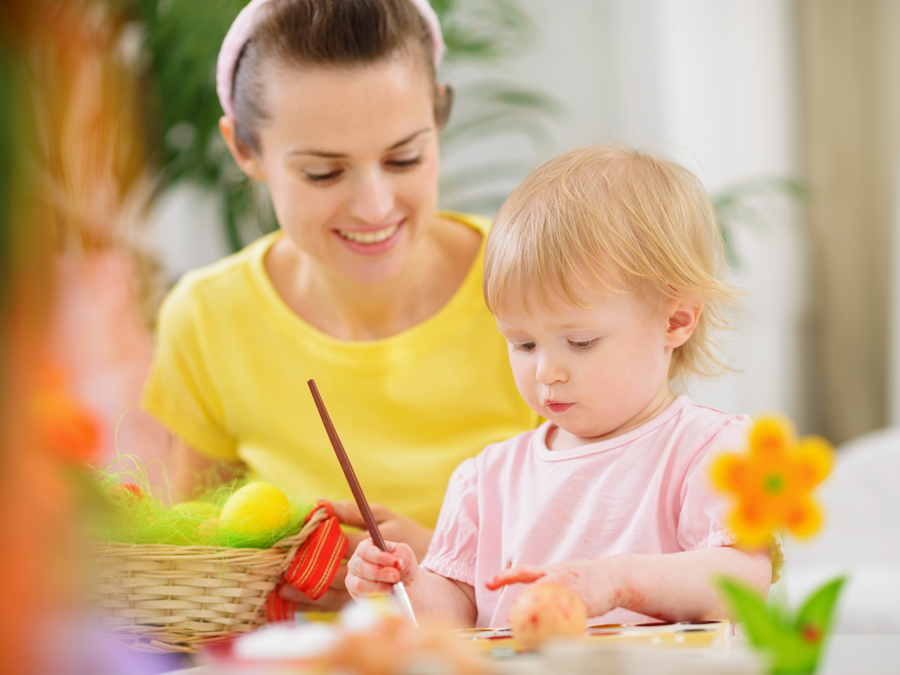Is creativity something we are born with? While we cannot answer “yes” in the literal sense, the capacity for creativity is a trait associated with even very young children. Creativity is about more than the colors someone chooses for a painting or drawing. It is a way of thinking, problem solving, and applying knowledge as well. Creativity is separate and different from intelligence, although the two can and do influence one another. From their earliest days, babies respond to contrasts, colors, sounds, and movements. How they integrate these various experiences will influence their growth and development across many areas, including creativity. In this way, creativity is ageless and timeless. Possibly more important, creativity can be acquired, and fostered.
Creativity can be developed through the various ways parents interact with and respond to very young babies. These may be seen in the diverse ways a caregiver might use to calm, soothe, comfort, engage, amuse, delight, enthrall, even confuse or confound their child. Playing creatively with babies — even newborns — fosters many aspects of development. The physical skills it promotes becomes one of the primary ways that babies learn about their world, thereby allowing them mental development and new ways of thinking, engaging, discovering, and problem solving. This growth may come from actual toys such as blocks, rings, or cups, but it may also come from cushions with bright colors or textures to explore, even objects that make interesting sounds will ignite a child’s curiosity.
Singing, cuddling, and interacting are important ways to participate in play, but it is equally important to encourage independent play time as well. For a young baby, this may be a toy that is foot operated (one of the first gross motor skills to come online is control of kicking) that they can enjoy without parental interaction. Such moments, built up over time, allow your child’s focus to be self-directed for periods, and allow a sense of curiosity and wonder to build.
Very young children learn about the world through their senses. Thus, to foster creativity and creative thinking right from the start, draw on this natural proclivity. Stimulating multiple senses, as babies develop the stamina, is a great way to foster imaginative thinking. A vast majority of your interactions should be hands-on activities where you and your baby interact face-to-face. However, there are also great ways to stimulate creativity with online interactions where parent and child are engaged in the experiences together. The element of surprise will also challenge your baby’s expectations, another great way to foster thinking.
Toddlers are ready for more when it comes to creative opportunities. Allow your child an expressive outlet for her thoughts, feelings, wishes, and imaginings. Challenge her new representational abilities by using her body in space: have her hop like a bunny, roar like a lion, etc. Get more abstract and see if he can become a kite, blowing in the wind, or a balloon blown too full that pops. Have her become a plane taking off or a lost kitten who finds its owner.
Challenge your child’s play to go beyond the familiar routine she may have developed. For example, fly your car to the moon. Look at everyday moments as opportunities to enhance creative thinking. Ask your child why she thinks the dog is chasing the squirrel, or where the bird that flew out of sight is off to. Ask your child what she thinks will happen next as events unfold in front of her, or make up her own ending to a story. While you are reading, have her start a new story the day after “happily ever after” and see where she goes with it. Along the same lines, bring literature to life: Act out We’re Going on a Bear Hunt by Michael Rosen, or the story of the Three Little Pigs. Then, surprise your child with an unexpected alternate ending!
Regardless of your child’s age, creativity is a process, as opposed to a product. This is especially true with babies and toddlers who are just developing the coordination to control and manipulate objects with intention, and the cognitive capacity to problem solve and organize thinking. Your excitement, enthusiasm, and interest will play a big part in what he continues to explore, and what he shies away from. So find ways to capture your child’s experience: photos of her painting, scribbles proudly hung at your child’s eye level, excited conversations relating your child’s experiments…even her frustrations or failures! Problems that are never faced cannot be problem-solved and overcome!


